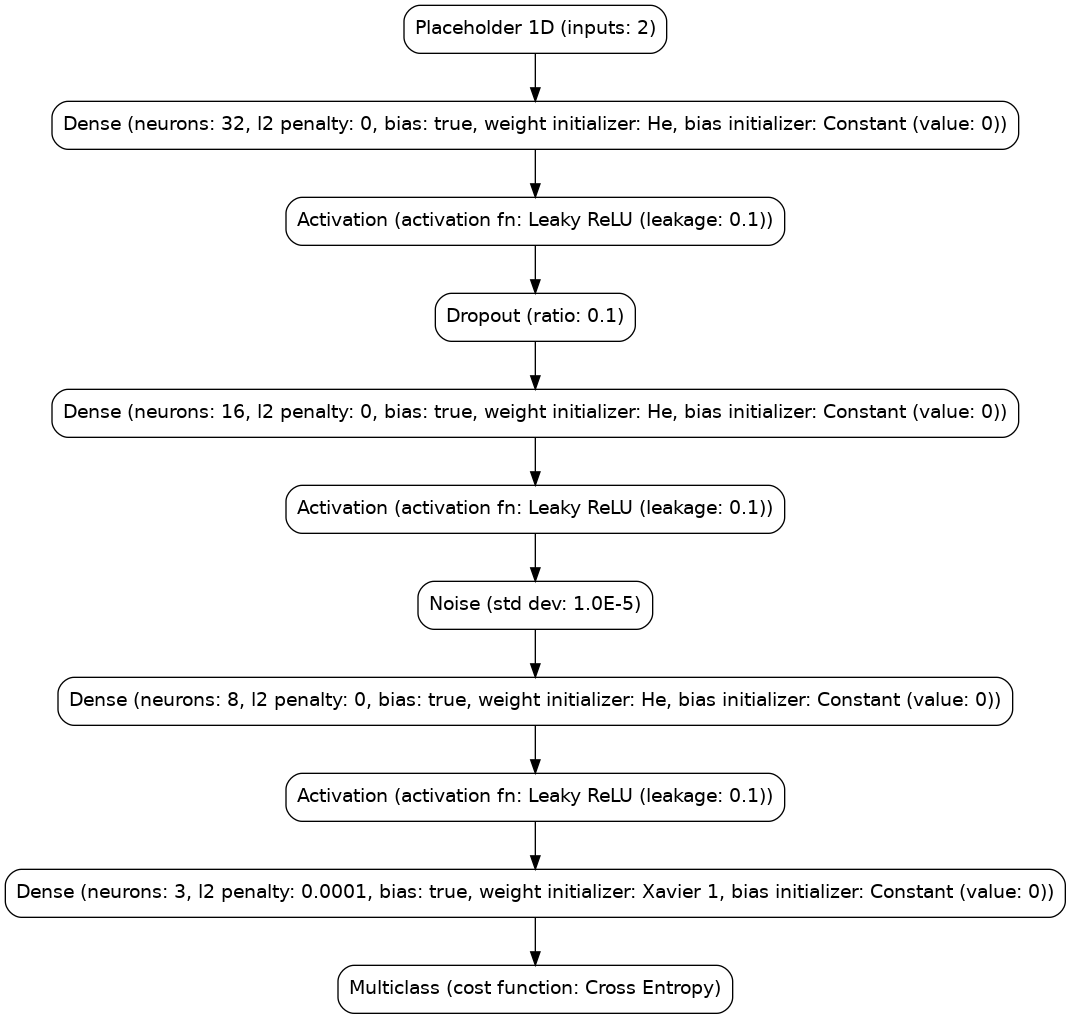MLP Regressor#
A multilayer feed-forward neural network with a continuous output layer suitable for regression problems. The Multilayer Perceptron regressor is able to handle complex non-linear regression problems by forming higher-order representations of the input features using intermediate user-defined hidden layers. The MLP also has network snapshotting and progress monitoring to ensure that the model achieves the highest validation score per a given training time budget.
Note
If there are not enough training samples to build an internal validation set with the user-specified holdout ratio then progress monitoring will be disabled.
Interfaces: Estimator, Learner, Online, Verbose, Persistable
Data Type Compatibility: Continuous
Parameters#
| # | Name | Default | Type | Description |
|---|---|---|---|---|
| 1 | hidden | array | An array composing the user-specified hidden layers of the network in order. | |
| 2 | batchSize | 128 | int | The number of training samples to process at a time. |
| 3 | optimizer | Adam | Optimizer | The gradient descent optimizer used to update the network parameters. |
| 4 | l2Penalty | 1e-4 | float | The amount of L2 regularization applied to the weights of the output layer. |
| 5 | epochs | 1000 | int | The maximum number of training epochs. i.e. the number of times to iterate over the entire training set before terminating. |
| 6 | minChange | 1e-4 | float | The minimum change in the training loss necessary to continue training. |
| 7 | window | 5 | int | The number of epochs without improvement in the validation score to wait before considering an early stop. |
| 8 | holdOut | 0.1 | float | The proportion of training samples to use for internal validation. Set to 0 to disable. |
| 9 | costFn | LeastSquares | RegressionLoss | The function that computes the loss associated with an erroneous activation during training. |
| 10 | metric | RMSE | Metric | The metric used to score the generalization performance of the model during training. |
Example#
use Rubix\ML\Regressors\MLPRegressor;
use Rubix\ML\NeuralNet\CostFunctions\LeastSquares;
use Rubix\ML\NeuralNet\Layers\Dense;
use Rubix\ML\NeuralNet\Layers\Activation;
use Rubix\ML\NeuralNet\ActivationFunctions\ReLU;
use Rubix\ML\NeuralNet\Optimizers\RMSProp;
use Rubix\ML\CrossValidation\Metrics\RSquared;
$estimator = new MLPRegressor([
new Dense(100),
new Activation(new ReLU()),
new Dense(100),
new Activation(new ReLU()),
new Dense(50),
new Activation(new ReLU()),
new Dense(50),
new Activation(new ReLU()),
], 128, new RMSProp(0.001), 1e-3, 100, 1e-5, 3, 0.1, new LeastSquares(), new RSquared());
Additional Methods#
Return an iterable progress table with the steps from the last training session:
public steps() : iterable
use Rubix\ML\Extractors\CSV;
$extractor = new CSV('progress.csv', true);
$extractor->export($estimator->steps());
Return the validation score for each epoch from the last training session:
public scores() : float[]|null
Return the loss for each epoch from the last training session:
public losses() : float[]|null
Returns the underlying neural network instance or null if untrained:
public network() : Network|null
Export a Graphviz "dot" encoding of the neural network architecture.
public exportGraphviz() : Encoding
use Rubix\ML\Helpers\Graphviz;
use Rubix\ML\Persisters\Filesystem;
$dot = $estimator->exportGraphviz();
Graphviz::dotToImage($dot)->saveTo(new Filesystem('network.png'));
